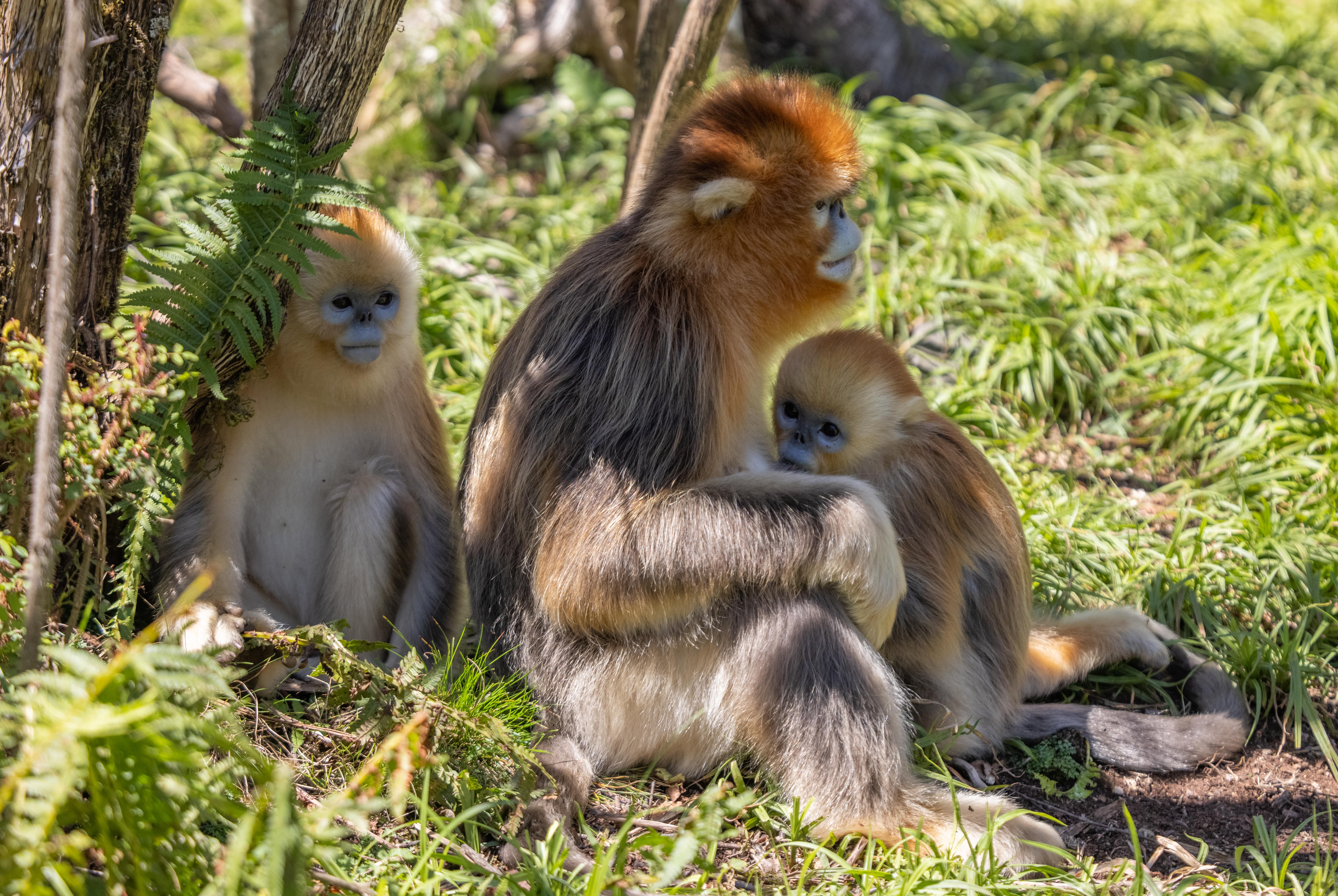Catch up! Explore the Mystical Shennongjia and Search for the "Monkey King"
Updated:2024-07-16 Source:Hubei Daily

Recently, a significant event that rare animals are buzzing about occurred in Shennongjia, the "Green Miracle" at the 31st parallel north.
Golden Pheasant:
Hey everyone, have you guys heard? In this primeval forest, some friends of us have changed their names!
Forest Musk Deer:
Could it be the "Golden Elves" ? Recently, the "two-legged beasts" have been tracking them, and it's been quite lively~
Golden Snub-nosed Monkey:
Alright, everyone, stop guessing~
Actually, It's me!
From June 29, 2024,
Please call me "Shennongjia Golden Snub-nosed Monkey."
Previous names:
"Sichuan Golden Snub-nosed Monkey Hubei Subspecies"
"Shennongjia Sichuan Golden Snub-nosed Monkey"
Clouded Leopard:
Why is that?
Researcher Li Ming from the Institute of Zoology
Chinese Academy of Sciences
There are significant differences between the Shennongjia Golden Snub-nosed Monkey population and the non-Shennongjia Golden Snub-nosed Monkey populations in terms of distribution characteristics, morphology, evolutionary history, genetic diversity, and adaptability. Therefore, the Sichuan Golden Snub-nosed Monkey Hubei subspecies can be referred to as the Shennongjia Golden Snub-nosed Monkey.
Golden snub-nosed monkey:
Renaming is indeed not easy!
I heard I will be protected and managed as an independent administrative unit~
In recent years, I clearly feel that the number of brothers and sisters in the forest is increasing
And, the "two-legged creatures (humans)" conducted a "monkey census"
Let's hear what they are talking about
An investigator in Shennongjia
At the Fourth Golden Snub-nosed Monkey Baseline Resource Survey Results Press Conference On June 29th, Shennongjia announced that:
The area is now home to 1,618 golden snub-nosed monkeys belonging to 11 groups
inhabiting an area of 401 square kilometers
Compared to the initial survey in 1990
The number of golden snub-nosed monkey populations in Shennongjia has increased by 6, or 83%.
The population has increased by 1,117 individuals, or 223%.
The habitat area has expanded by 237 square kilometers, or 145%.
Eurasian eagle-owl:
The golden snub-nosed monkey is a "national treasure" animal on par with the giant panda.
They migrate in search of food and are naturally vigilant.
In the vast primeval forest,
how do researchers count the number of golden snub-nosed monkeys?
A multimedia journalist from Hubei Daily
It's our turn to take the stage!
Please join us as we enter the uninhabited area.
We will lead everyone to witness how researchers search for the "Monkey King".
Act I
Entering the mountains
Syncing with the golden snub-nosed monkeys
Du Hua, Director of the Education Department at Shennongjia National Park Administration:
Golden snub-nosed monkeys are active at sunrise and rest at sunset. They also take a nap for two to three hours at noon. Therefore, researchers' work hours must synchronize with those of the golden snub-nosed monkeys.
A multimedia journalist from Hubei Daily
Roger that.
At 5:30 AM, rendezvoused with 12 researchers and headed to the Yousongping area at an altitude of over 2,000 meters above sea level.
In the primeval forest, not all trees tower into the sky; many are as thick as bowls or basins. There are also numerous shrubs under the canopy, requiring researchers to sometimes crawl on the ground to pass through.
A multimedia journalist from Hubei Daily
Nature is truly amazing. Large trees, small trees, shrubs, and wild grasses coexist in such harmony.
Act II
Fruitless Efforts
Group and Zone Allocation
Searching for the Monkey
The team of twelve is divided into four groups
Everyone pursued the golden snub-nosed monkeys in different directions. They agreed to regroup at the starting point after finishing their dry rations at noon.
A multimedia journalist from Hubei Daily
Navigating through the forest makes it challenging to maintain direction.
Are there concerns about overlapping or missing areas in our investigation?
Investigator Xiao Chuanhua
The survey area will be divided into 400 grids. Our team members will systematically investigate each grid to ensure no overlap or omission. Additionally, team members will carry PDA terminals to record their movement trajectories. Hair and feces of the golden snub-nosed monkeys will be collected for DNA analysis, ensuring no double-counting even upon multiple "encounters" with the same troop. If troops enter grids that have already been surveyed, we will use leftover hair DNA to relocate them accurately.
Unfortunately,
the group that includes the multimedia journalist from Hubei Daily still didn't manage to find any traces of the golden snub-nosed monkeys, which was quite disheartening.
Investigator Xiao Chuanhua
Look, we did make some gains. We marked the coordinates of four rare plant species.
Every time we enter the mountains, we record rare animals and plants to enhance the overall species distribution database of Shennongjia.
Around 1:00 (PM) that afternoon,
the four groups returned to the starting point one after another.
Similarly, they didn't find the golden snub-nosed monkeys either.
It seems that the "Monkey King" truly comes and goes without a trace!
Act III
Chasing
New Technologies
Ensuring Data Accuracy
Investigator Xiao Chuanhua,
Colleagues conducting surveys in the Shennong Peak area have found the golden snub-nosed monkeys! Let's go!
Rushing to Shennong Peak.
Guided by the investigators,
The journalist observed six or seven golden snub-nosed monkeys active in the trees about seventy to eighty meters away.
Some were eating leaves and some were jumping and playing,
And others were grooming each other, searching for lice.
In the distance,
a drone flew over the troop of monkeys,
constantly taking photos
Yao Hui, Deputy Director of the Scientific Research Institute of Shennongjia National Park Administration
In this golden snub-nosed monkey survey, we applied four new technologies:
1.Utilizing drones equipped with infrared sensors to take aerial photographs, accurately counting the specific number of golden snub-nosed monkeys.
2.Extracting DNA from intestinal wall cells in feces to identify different troops, resolving the issue of duplicate troop counting.
3.Using genetic extraction, amplification, and sequencing to understand the feeding preferences of different golden snub-nosed monkey troops.
4.Using remote sensing technology to accurately identify the habitats of golden snub-nosed monkeys.
Behind this
The ecological environment of Shennongjia continues to improve.
Behind this extraordinary encounter lies over two months of investigation efforts by researchers.
The overall study was divided into field surveys and laboratory analyses.
During the field surveys, a total of 840 person-times were deployed, covering 240 survey routes and traveling a total of 58,800 kilometers.
Chief Expert Li Diqiang
Institute of Forest Ecology, Environment, and Protection
Chinese Academy of Forestry
The number of species and number of golden snub-nosed monkeys in Shennongjia are steadily increasing, and their habitat area is also continuously expanding. These developments indicate a significant improvement in the ecological environment of Shennongjia, reflecting substantial progress in the conservation and research of golden snub-nosed monkeys.
The snub-nosed monkey,
This is a paradise of flora and fauna
and the homeland of "wild men".
Here on the "roof of central China", we thrive and live comfortably!
Produced by the Converged Media Center of Hubei Daily
Reporters: Liu Hanze, Liu Shusong, Wu Jian, Yu Kuanhong
Creator: Wan Leimeng
Art: Luo Yi
Coordinator: Zhao Shasha
Reviewers: Zhang Lei, Chen Huijun
Source: Shennongjia National Park
Editor-in-Charge: Wan Leimeng Copyright Shennongjia National Park
Address:36 Chulin Road, Muyu Town, Shennongjia Forestry District, Hubei Province 鄂ICP备18005077号-3
Address:36 Chulin Road, Muyu Town, Shennongjia Forestry District, Hubei Province 鄂ICP备18005077号-3
Email:2673990569@qq.com
Phone:0719-3453368
Phone:0719-3453368


TOP

